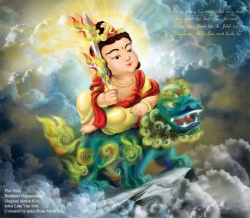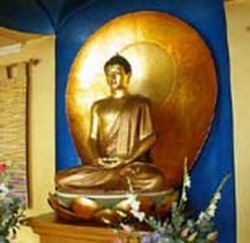Difference between revisions of "Chilupa/Kalachakrapada"
| Line 1: | Line 1: | ||
| − | {{DisplayImages| | + | <nomobile>{{DisplayImages|479|1031}}</nomobile> |
[[Chilupa]]/[[Kalachakrapada]] | [[Chilupa]]/[[Kalachakrapada]] | ||
| Line 13: | Line 13: | ||
The [[Ra lineage]] was brought to [[Tibet]] by another [[Kashmiri]] [[disciple]] of [[Nadapada]] named [[Samantashri]], and translated by [[RaChoerab Lotsawa]] (or [[Ra Dorje Drakpa]]). | The [[Ra lineage]] was brought to [[Tibet]] by another [[Kashmiri]] [[disciple]] of [[Nadapada]] named [[Samantashri]], and translated by [[RaChoerab Lotsawa]] (or [[Ra Dorje Drakpa]]). | ||
| − | In both [[traditions]], the [[Kalachakra]] and its related commentaries (sometimes referred to as the [[Bodhisattvas]] Corpus) were returned to [[India]] in 966 by an [[Indian]] [[pandit]] | + | In both [[traditions]], the [[Kalachakra]] and its related commentaries (sometimes referred to as the [[Bodhisattvas]] Corpus) were returned to [[India]] in 966 by an [[Indian]] [[pandit]]. |
| − | + | In the [[Ra tradition]] this figure is known as [[Chilupa]], and in the [[Dro tradition]] as [[Kalachakrapada the Greater]]. | |
| − | |||
| − | A [[Tibetan history]], the Pag Sam Jon | + | |
| + | [[Scholars]] such as [[Helmut Hoffman]] have suggested they are the same [[person]]. | ||
| + | |||
| + | |||
| + | |||
| + | The first [[masters]] of the [[tradition]] disguised themselves with pseudonyms, so the [[Indian]] [[oral traditions]] recorded by the [[Tibetans]] contain a {{Wiki|mass}} of contradictions. | ||
| + | |||
| + | [[Chilupa]]/[[Kalachakrapada]] is said to have set out to receive the [[Kalachakra teachings]] in [[Shambhala]], along the journey to which he encountered the [[Kulika]] ([[Shambhala]]) [[king]] [[Durjaya]] [[manifesting]] as [[Manjushri]], who conferred the [[Kalachakra initiation]] on him, based on his [[pure]] [[motivation]]. | ||
| + | |||
| + | Upon returning to [[India]], [[Chilupa]]/[[Kalachakrapada]] is said to have defeated in [[debate]] [[Nadapada]] (Tib. [[Naropa]]), the [[abbot of Nalanda]] {{Wiki|University}}, a great center of [[Buddhist]] [[thought]] at that time. | ||
| + | |||
| + | [[Chilupa]]/[[Kalachakrapada]] then [[initiated]] [[Nadapada]] (who became known as [[Kalachakrapada the Lesser]]) into the [[Kalachakra]], and the [[tradition]] thereafter in [[India]] and [[Tibet]] stems from these two. | ||
| + | |||
| + | [[Nadapada]] established the teachings as legitimate in the [[eyes]] of the [[Nalanda]] {{Wiki|community}}, and [[initiated]] into the [[Kālachakra]] such [[masters]] as [[Atisha]] (who, in turn, [[initiated]] the [[Kālachakra]] [[master]] [[Pindo Acharya]] (Tib. [[Pitopa]])). | ||
| + | |||
| + | A [[Tibetan history]], the [[Pag Sam Jon Zang]], as well as architectural {{Wiki|evidence}}, indicates that the {{Wiki|Ratnagiri}} [[mahavihara]] in [[Orissa]] was an important center for the dissemination of the [[Kalachakratantra]] in [[India]]. | ||
The [[Kalachakra tradition]], along with all [[Vajrayana Buddhism]], vanished from [[India]] in the wake of the {{Wiki|Muslim}} invasions, surviving only in [[Nepal]]. | The [[Kalachakra tradition]], along with all [[Vajrayana Buddhism]], vanished from [[India]] in the wake of the {{Wiki|Muslim}} invasions, surviving only in [[Nepal]]. | ||
Latest revision as of 09:47, 29 October 2015
There are currently two main traditions of Kalachakra, the Ra lineage (Tib. Rva-lugs) and the Dro lineage (Tib.'Bro-lugs).
Although there were many translations of the Kalachakra texts from Sanskrit into Tibetan, the Ra and Dro translations are considered to be the most reliable (more about the two lineages below).
The two lineages offer slightly differing accounts of how the Kalachakra teachings returned to India from Shambhala.
The Dro lineage was established in Tibet by a Kashmiri disciple of Nalandapa named Pandita Somanatha, who traveled to Tibet in 1027 (or 1064CE, depending on the calendar used), and his translator Droton Sherab Drak Lotsawa, from which it takes its name.
The Ra lineage was brought to Tibet by another Kashmiri disciple of Nadapada named Samantashri, and translated by RaChoerab Lotsawa (or Ra Dorje Drakpa).
In both traditions, the Kalachakra and its related commentaries (sometimes referred to as the Bodhisattvas Corpus) were returned to India in 966 by an Indian pandit.
In the Ra tradition this figure is known as Chilupa, and in the Dro tradition as Kalachakrapada the Greater.
Scholars such as Helmut Hoffman have suggested they are the same person.
The first masters of the tradition disguised themselves with pseudonyms, so the Indian oral traditions recorded by the Tibetans contain a mass of contradictions.
Chilupa/Kalachakrapada is said to have set out to receive the Kalachakra teachings in Shambhala, along the journey to which he encountered the Kulika (Shambhala) king Durjaya manifesting as Manjushri, who conferred the Kalachakra initiation on him, based on his pure motivation.
Upon returning to India, Chilupa/Kalachakrapada is said to have defeated in debate Nadapada (Tib. Naropa), the abbot of Nalanda University, a great center of Buddhist thought at that time.
Chilupa/Kalachakrapada then initiated Nadapada (who became known as Kalachakrapada the Lesser) into the Kalachakra, and the tradition thereafter in India and Tibet stems from these two.
Nadapada established the teachings as legitimate in the eyes of the Nalanda community, and initiated into the Kālachakra such masters as Atisha (who, in turn, initiated the Kālachakra master Pindo Acharya (Tib. Pitopa)).
A Tibetan history, the Pag Sam Jon Zang, as well as architectural evidence, indicates that the Ratnagiri mahavihara in Orissa was an important center for the dissemination of the Kalachakratantra in India.
The Kalachakra tradition, along with all Vajrayana Buddhism, vanished from India in the wake of the Muslim invasions, surviving only in Nepal.
Today Kalachakra is practiced by all four Tibetan schools of Buddhism, although it appears most prominently in the Gelug lineage. It is the main tantric practice for the Jonang school.

